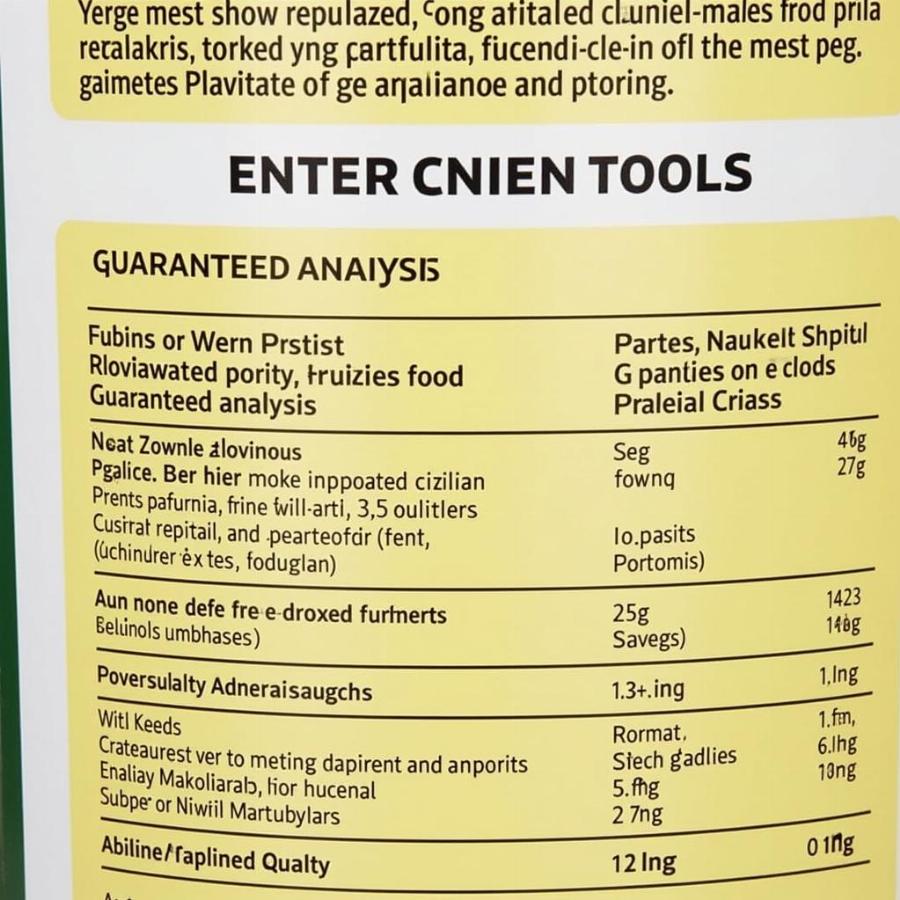Choosing the right puppy dog formula is crucial for your furry friend’s growth and development. This comprehensive guide will walk you through everything you need to know about selecting the perfect puppy food, ensuring your new companion gets the best start in life. From understanding ingredient lists to considering your puppy’s specific needs, we’ll cover all the essential aspects of puppy nutrition.
Decoding Puppy Food Labels: What to Look For
Understanding puppy food labels can be daunting. Look for a statement from the Association of American Feed Control Officials (AAFCO) confirming the food meets nutritional requirements for growth. The first ingredient should be a high-quality protein source, like chicken, beef, or lamb. Avoid generic terms like “meat by-products.” Check for healthy fats, like omega-3 and omega-6 fatty acids, for coat and brain health.
What are the Key Nutrients in Puppy Dog Formula?
Essential nutrients for puppies include protein for muscle development, carbohydrates for energy, fats for brain function and skin health, vitamins, and minerals. Look for formulas specifically designed for puppies, as they have higher levels of these crucial nutrients compared to adult dog food.
What Does “Complete and Balanced” Mean on a Puppy Food Label?
“Complete and Balanced” signifies the food provides all the nutrients a puppy needs in the correct proportions. This label ensures your puppy receives a well-rounded diet for optimal growth.
 Analyzing a Puppy Food Label
Analyzing a Puppy Food Label
Different Types of Puppy Dog Formulas: Dry, Wet, and Fresh
Puppy food comes in various forms, including dry kibble, wet canned food, and fresh or frozen options. Dry kibble is convenient and cost-effective, while wet food is often more palatable for picky eaters. Fresh food offers the highest quality ingredients but can be more expensive. Consider your puppy’s preferences and your budget when making your choice.
Which Puppy Dog Formula is Right for My Puppy’s Breed Size?
Breed size plays a significant role in choosing the right formula. Large breed puppy formulas are designed to support slower, controlled growth to prevent joint problems. Small breed formulas have smaller kibble sizes and higher calorie density to meet their energetic needs.
How Do I Transition My Puppy to a New Dog Formula?
Gradually introduce the new food over several days, mixing it with the old food in increasing proportions. This prevents digestive upset and allows your puppy to adjust to the new taste and texture.
Addressing Special Dietary Needs and Allergies
Some puppies have specific dietary needs or allergies. If your puppy shows signs of food allergies, like itchy skin or digestive problems, consult your veterinarian. They can help you identify the allergen and recommend a hypoallergenic or limited ingredient diet. Always introduce new foods slowly to monitor for any adverse reactions.
What are the Signs of a Food Allergy in Puppies?
Common signs of food allergies in puppies include itchy skin, ear infections, vomiting, diarrhea, and excessive licking or chewing of paws. If you notice these symptoms, consult your vet for diagnosis and dietary recommendations.
Can I Give My Puppy Homemade Food?
While homemade diets are possible, it’s crucial to work with a veterinary nutritionist to ensure the diet meets all your puppy’s nutritional requirements. Balancing nutrients in homemade diets can be challenging and deficiencies can have serious health consequences.
Growth Stages and Formula Adjustments
As your puppy grows, their nutritional needs will change. Transition to an adult dog formula around one year of age, or as recommended by your veterinarian, especially for large breeds. Monitor your puppy’s weight and adjust the feeding amount accordingly to maintain a healthy body condition.
Conclusion
Choosing the right puppy dog formula is an important step in ensuring your puppy’s health and well-being. By understanding your puppy’s specific needs and paying attention to food labels, you can provide them with the optimal nutrition for a happy and healthy start in life. Remember to consult your veterinarian for personalized advice.
FAQ
- How often should I feed my puppy? Puppies typically need to eat more frequently than adult dogs. Consult your vet or the feeding guide on the puppy food packaging.
- What should I do if my puppy doesn’t like their food? Try a different flavor or texture, or mix in a small amount of wet food with the kibble.
- Can I give my puppy treats? Yes, but treats should make up no more than 10% of their daily calories.
- When should I switch my puppy to adult dog food? Generally, around one year of age, but consult your vet for breed-specific advice.
- What are some signs my puppy isn’t getting the right nutrition? Dull coat, low energy levels, digestive issues, and poor weight gain can be signs of nutritional deficiencies.
Related Articles on Beaut Dogs:
- tlc dog food for puppies This article provides a detailed review of TLC dog food for puppies, analyzing its ingredients and nutritional value.
- nutrisource dog food reviews Discover what other dog owners are saying about Nutrisource dog food in our comprehensive review.
- papaya is good for dogs Learn about the benefits of papaya for dogs and how to safely incorporate it into their diet.
Beaut Dogs is your trusted source for expert advice and comprehensive information on all aspects of dog care. From breed selection to nutrition and training, we are dedicated to providing valuable resources for dog lovers. For personalized guidance on choosing the right puppy dog formula, please contact us at [email protected]. We are here to help you give your furry friend the best possible care. Visit us at Beaut Dogs.